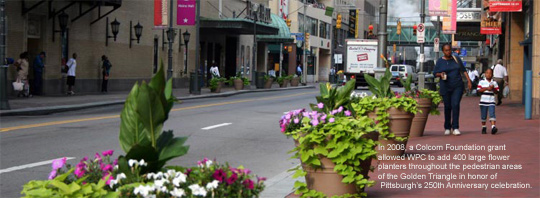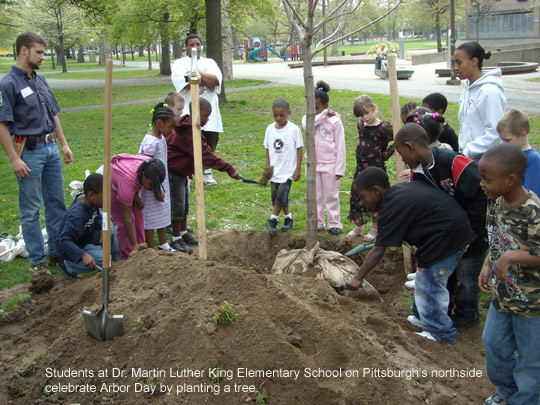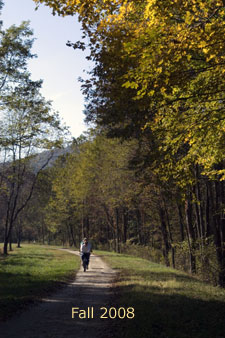CONSERVE | FALL 2008
Community Roots Grow Stronger Through New Greening Opportunities
Western Pennsylvania
Conservancy has extended its
reach to improve the local
quality of life through gardens and
other green spaces within cities and
towns throughout the region. In
addition to its successful community
floral gardens that have positively
highlighted Western Pennsylvania
counties since the late 1980s, the
program has launched three new
initiatives to enhance our local
landscapes. Each of these greening
strategies opens up new directions
for improving our communities.
.
Downtown Greening
To support the city’s interest in
attracting residents to downtown
Pittsburgh, WPC is working on several
aspects of the Golden Triangle’s
environment. Last fall, WPC ompleted
an assessment of opportunities to
add green features to the downtown
area; the assessment identified
numerous opportunities, large and
small, simple and audacious.
With the longtime support of the Laurel Foundation, WPC expanded the number of hanging flower baskets throughout the downtown region, bringing the total number of baskets to 450. We have added baskets along the Rachel Carson Bridge and some new areas in Gateway Center. PNC Firstside also added baskets along the perimeter of the new park on Grant and First.
“This year we’ve been able to
extend to other Pittsburgh business
centers,” said Judy Wagner, senior
director of the Community Gardens
and Greenspace Program. “In
addition to the 450 hanging baskets
we have downtown, we’ve placed 105
baskets on the South Side and another
26 in East Liberty. This is a wonderful
example of how the leadership of the
Laurel Foundation has inspired other
community leaders to take action. It’s
becoming clear that greening our
streets and communities is a powerful
tool for revitalization.”
Thanks to a generous Colcom Foundation grant in honor of the city’s 250th birthday, WPC was also able to add 400 large flower planters throughout the pedestrian areas of the Golden Triangle.
In the future, WPC will be working with city leaders to pursue other opportunities to add greenery to downtown, making it more livable and attractive to those who work and visit as well as to new city residents, who are a pivotal part of the city’s revitalization.

School Greening
Studies have found that children
spend 20 to 25 percent of their school
time in the schoolyard...the equivalent
of 257 days by the end of sixth grade.
Evidence further suggests that greenery,
including views from classrooms,
play spaces, school landscapes and
even interior spaces, can:
- ignite a child’s curiosity and overall sense of wonderment;
- engage, lengthen, and sharpen attention span;
- reduce agitation and disengaged behavior;
- establish a healthy connection and understanding of the way natural systems work.
All of these benefits can have a
positive impact on learning.
Since 1996, the Conservancy has
worked with The Grable Foundation
on school greening projects, and it is
with their continued support that the
new School Grounds Initiative came
into being. In 2007, the Conservancy
and The Grable Foundation approached
the Pittsburgh School
Board with a new concept that would
include working directly with school
grounds’ staff to add sustainable,
low-maintenance greenery to school
properties, to enhance the experience
of students and the adjacent
neighborhoods. Late last year,
Superintendent Mark Roosevelt
endorsed the proposed project and
The Grable Foundation awarded a
$1.5 million grant to the Conservancy
to support a four-year effort that will
increase the green components of 65
school grounds.
This project will add several types
of greenery on each school property.
Some examples of green additions
include: raised beds to provide easier
access for ongoing school projects,
quiet spaces with plants and seating
for teachers and students, “green”
fences and walls enhanced with
vegetation, additional trees, and active
play spaces with natural surfaces.

TreeVitalize
A 2005 street tree inventory
revealed that Pittsburgh currently has
one street tree for every 11 residents,
far below the 1:3 ratio found in 22
other cities surveyed in a U.S. Forest
Service study. In some Pittsburgh
communities there are as few as one
tree for every 22 people.
Trees enhance neighborhoods,
produce oxygen, reduce pollution,
capture rainwater and provide habitat
for animals and other creatures. The
new TreeVitalize Pittsburgh program
will help significantly improve the
quality of life in the Pittsburgh region
by planting up to 20,000 trees
by 2012.
“The urban forest is an environmental
workhorse,” said TreeVitalize
Director Marijke Hecht. “Community
forestry brings these environmental
benefits together with the simple and
wonderful act of neighbors planting
trees together. With TreeVitalize
Pittsburgh we are building stronger
communities and improving the
environment for the people who live
here in Allegheny County.”
TreeVitalize Pittsburgh, launched
this year and funded by the Heinz
Endowments and the Pennsylvania
Department of Conservation and
Natural Resources (DCNR), is a joint
project of the Western Pennsylvania
Conservancy, Allegheny County, the
City of Pittsburgh, and DCNR.
TreeVitalize will also rely on partnerships
with community groups,
nonprofits and other municipal
agencies. WPC coordinates the
efforts of the TreeVitalize partners and
provides support for community
outreach, volunteer activities, media
relations, planting logistics and
fundraising for the project.

